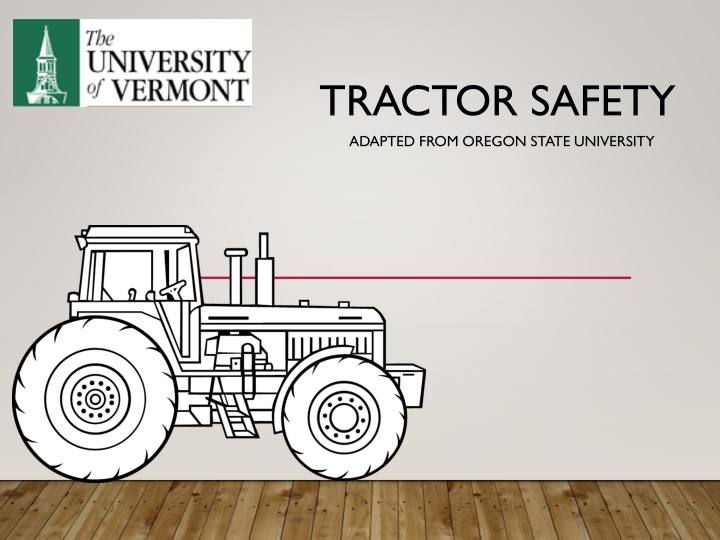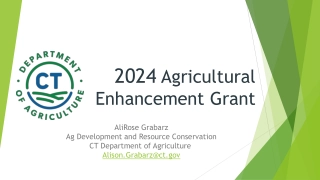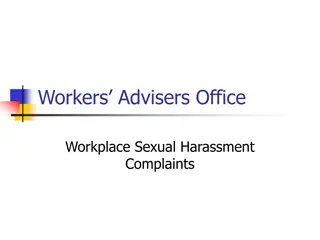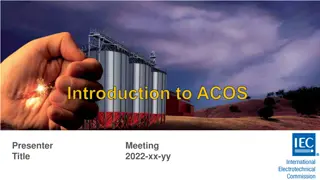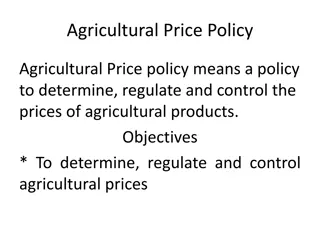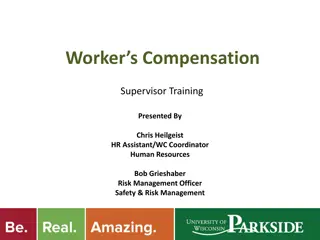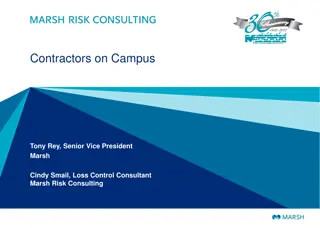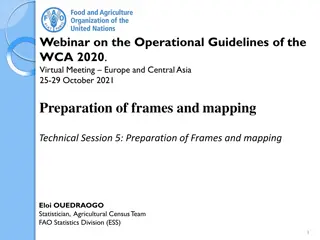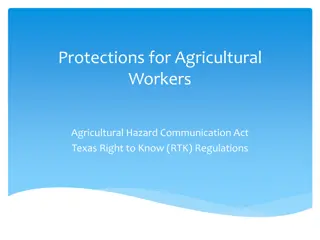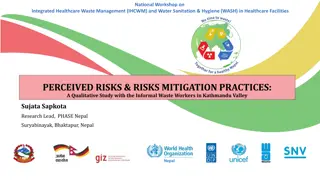Tractor Safety Guidelines and ROPS Standards for Agricultural Workers
Tractor safety is paramount in the agricultural sector to prevent accidents and fatalities. Employers must provide essential safety measures such as roll-over protection structures, seat belts, and training to ensure worker well-being. Negligence and improper maintenance are leading causes of machinery-related accidents. The U.S. Department of Labor highlights the dangers of farming activities, with tractors being involved in a significant percentage of farm-related deaths. The Roll-Over Protective Structure (ROPS) Standard mandates the installation of protective structures on tractors manufactured after October 26, 1976, to prevent overturn incidents. Adequate training and adherence to safe operation practices are crucial for farm workers' safety.
Download Presentation

Please find below an Image/Link to download the presentation.
The content on the website is provided AS IS for your information and personal use only. It may not be sold, licensed, or shared on other websites without obtaining consent from the author.If you encounter any issues during the download, it is possible that the publisher has removed the file from their server.
You are allowed to download the files provided on this website for personal or commercial use, subject to the condition that they are used lawfully. All files are the property of their respective owners.
The content on the website is provided AS IS for your information and personal use only. It may not be sold, licensed, or shared on other websites without obtaining consent from the author.
E N D
Presentation Transcript
TRACTOR SAFETY ADAPTED FROM OREGON STATE UNIVERSITY
TRACTOR SAFETY OSHA requires employers to provide their employees with: A standard roll-over protection structure A standard seat belt Protection from tractor fluid spillage Protection from sharp surfaces Training, including hands-on training from an experienced operator Guarding for Power Take-Off (PTO) shafts & equipment
TRACTOR SAFETY Although today s tractors are the safest ever, they are still involved in many farm accidents. Statistics show that most machinery-related accidents occur due to human negligence. These errors include improper or lack of machinery maintenance, taking shortcuts to save time, ignoring warnings, failure to follow safety rules,and failure to read the operator s manual.
TRACTOR SAFETY According to the U.S. Department of Labor, farming is ranked as one of the most dangerous occupations by number of fatalities A 2017 census reported that nearly 40% of farm-related deaths involved a tractor. [U.S. Dept. of Labor, Bureau of Labor Statistics, National Census of Fatal Occupational Injuries in 2017] NIOSH (the National Institute for Occupation Safety and Health) reported in 2016 that tractor overturns were the leading cause of death for farm workers
ROLL-OVER PROTECTIVE STRUCTURE STANDARD A seat belt and roll bar or protective cabin could have prevented almost all of these deaths. Because of this, the Department of Labor has established the Roll-Over Standard, or ROPS Standard. The standard requires that all tractors manufactured after October 26, 1976 must have Roll-Over Protective Structures. Protective Structure
ROLL-OVER PROTECTIVE STRUCTURE STANDARD The ROPS Standard also requires that employees receive the following training in the areas of safe tractor operation: Seat belts must be worn when operating machinery equipped with ROPS. Avoid driving near ditches or holes, on very rough ground, and over stumps and large rocks. Drive at the appropriate speed for the job, the terrain, and the machine. Stay off steep slopes. Watch where you are going. Don t permit others to ride. Operate the tractor smoothly: no jerky movements, starts or stops. Hitch only to the drawbar and hitch points recommended by the tractor manufacturer. When the tractor is stopped, set brakes securely.
ALWAYS USE ROPSAND SEAT BELT Rollover Protective Structures (ROPS) do not prevent rollovers, but are 95% effective in preventing death or serious injury. If you have a foldable ROPS, keep it in the up position and always use a seatbelt. Only fold it down when you must and do not use the seatbelt when the ROPS is folded down. A ROPS and seatbelt assures that you will stay in the protective zone . Never modify a ROPS by drilling, cutting, grinding, welding, etc. This could weaken the frame and cause it to fail in the event of an overturn.
ALWAYS USE ROPSAND SEAT BELT A rollover happens so fast, your human reflexes cannot possibly react in time to change the outcome. Typically, a victim of a tractor rollover without ROPS protection will injuries such as broken bones, lacerations and Crushing head, chest and pelvic injuries, along lungs should also be expected. experience contusions. TRACTOR HITS DEPRESSION & TIPS with collapsed
TRACTOR SAFETY The most important point of tractor safety is knowing your tractor. Know how it handles and be prepared for emergencies. Tractor operators must be trained for the specific tractor(s) they will be operating. All training of employees must incorporate the operator s manual. A good tractor operator has been trained by a person experienced with the particular tractor being used, has read the instruction manual, and practices good safety habits.
1. Rollover Protective Structure (RoPS). 2. Flashing amber light for towing on roads. 3. Rear tail and work lights. 4. Mudguards. 5. Side light. 6. Seat-belt. 7. Posture designed seat. 8. Manual over-ride power steering. 9. Maximum visibility. 10. Hazard warning decals. 11. Hydraulic power for heavy lifting. 12.Three point hitch to prevent back-flipping. 13. Draw-bar located low to minimize back-flipping. 14. Protective PTO shaft cover. 15. PTO shield. 16. Controls conveniently located. 17. Skid-resistant platform and footrest. 18. Neutral start switch with safety interlock. 19. Shroud and shield for fan and alternator. 20. Weights for greater stability and traction. 21. Sun-shield to reduce risk of skin cancer. 22. Headlights.
TRAINING TRACTOR OPERATORS Train new and inexperienced operators for every tractor they will be driving. Point out special hazards on the farm and how to avoid them. Have operator practice in large, level field or yard. Trainer should drive around yard, demonstrating how controls operate. Trainer should walk near the tractor as the student drives, giving instruction. After the student has learned to operate the tractor alone in a level area, then attach and operate additional implements.
FAMILIARIZE YOURSELF WITH THE TERRAIN Walk the area first. Use special caution on slopes. Slow down for turns. Avoid the roadway if possible. Be especially aware of conditions at the end of rows.
OPERATING ON SLOPED GROUND Most tractor overturns occur to the side. Typical causes include hitting an obstacle, operating on steep slopes, using front-end loaders and operating at excessive speeds. In many cases, an implement is attached to the tractor or being towed. The attached equipment can increase the severity of the accident and complicate rescue operations.
CENTER OF GRAVITY Do not operate the tractor at excessive speeds, especially when turning. A higher center of gravity allows a side overturn to occur more quickly
KEEP LOADS LOW WHILE TRANSPORTING Driving with a front-end loader too high changes the center of gravity of your tractor. It raises the center of gravity, making it 'top heavy'. A sudden turn or raising the tractor on one side can cause a side rollover. The problem is compounded when the loader has material in it, especially if it is not evenly distributed.
STARTING AND FUELING Never start an engine in a closed shed or garage. Never refuel while the engine is running or hot. Always shut the tractor down when adding fluids, fuels, and performing maintenance. A spark from the ignition system or hot exhaust could cause the fuel to ignite. Always refuel tractors outside. Grounding out the tractor with a ground wire or by dropping mounted equipment so it touches the ground can reduce static electricity.
PREVENT PTO ACCIDENTS Always keep your power take-off (PTO) properly shielded. PTO accidents cause serious injury or death. Human reflexes cannot compete with the speed and power of a rotating PTO shaft. Once caught, a victim has no time to escape. PTO properly shielded Clothing caught on unguarded PTO
PREVENT PTO ACCIDENTS Ensure that PTO shields are in place before work begins. Replace cracked or defective shields immediately. Stop PTO before dismounting. Keep clothing, hair, and all body parts away from a rotating PTO. Do not wear loose-fitting clothing when working in a close proximity to rotating or revolving power equipment. Never step over a rotating PTO shaft. Always use the driveline or PTO shaft recommended for your machine. Never use parts of one brand of machine in another model. Position the drawbar properly for each type of implement used.
PROPERLY POSITION HITCHES Keep hitches low and always on the draw bar. Hitching above the drawbar may tip a tractor backwards. Always use hitch pins with safety catches to prevent accidental un- hitching. A safety chain hook-up is also required when towing equipment on the road.
PREVENT REAR OVERTURNS Front chassis weights can be used to counterbalance rear-mounted implements and heavy drawbar loads. Always start forward motion gradually.
PREVENT REAR OVERTURNS Whenever possible, back tractors UP steep slopes, and come DOWN forward. If you have to back down a slope, do it slowly in a low gear. Never put boards or logs in front of drive wheels. Back out if you are stuck in the mud.
DISMOUNT PROPERLY Never get off a moving tractor or leave it with its engine running. Shut the tractor off, set the parking brake, then dismount. Don t start the engine from anywhere but the seat. When the tractor has been left running, and the operator is not in the tractor seat, there is the possibility that the tractor will malfunction in some way, start moving, and run over you or bystanders. A moving tractor can also damage or become damaged by objects in the area.
NO RIDERS The number of seats equals the number of riders. There is no safe place either on the tractor or on any of the implements. Even a small bump can cause a rider to fall off and be run over.
DONT HURRY Never be in a hurry or take chances on anything to do with a tractor. There is always time to assure that your next step will not be your last step. A tractor is a workhorse, not a racehorse. A tractor is designed for maneuverability at low speeds, not high speeds. Slow down on turns or curves. A tractor s center of gravity is higher than a car s, and a fast sharp turn can result in a side rollover.
NOISE FROM TRACTORS AND MACHINERY With continual exposure to excessive noise, the ability to hear normal conversation is impaired. Noise is too loud when: Your ears ring after prolonged exposure to noise. Speech and other sounds seem muffled after exposure. You lose the ability to tell musical tones apart. You fail to hear high pitched sound.
NOISE FROM TRACTORS AND MACHINERY Continual exposure to noise at high decibel levels over a period of time may lead to permanent hearing loss. A tractor under load may produce noise levels of over 100 decibels. The maximum permissible exposure limit (PEL) for an 8 hour work period is 90 decibels. If you were operating a tractor at 100 decibels, the permissible daily exposure would only be two hours! At 115 decibels, the limit is only 15 minutes! If you do not have a cab that reduces noise significantly you may need to wear hearing protection in the form of ear plugs or muffs designed to block out harmful noise levels.
GENERAL GUIDELINES FOR SAFE TRACTOR OPERATION Tractors must be equipped with master shields, safety guards, bypass starter covers, Slow Moving Vehicle (SMV) emblems and emergency lighting. Tractors must not transport extra passengers. Keep all people away from work areas and machinery unless they are actively involved in the work. When refueling, parking or leaving machinery for any length of time, shut down all motors, engage brakes, remove keys and disengage any attachments.
GENERAL GUIDELINES FOR SAFE TRACTOR OPERATION When working with a front-end loader in an area with falling debris, Falling Object Protective Structures (FOPS) should be used. If used on public roadways, farm equipment must have lights conforming to state motor vehicle codes. Use hand signals during operation if noise is an issue. The American Society of Agricultural Engineers (ASAE) has developed a standardized system that is available to agricultural workers. Never clean or unclog machinery until the motor is shut off and all moving parts have stopped.
GENERAL GUIDELINES FOR SAFE TRACTOR OPERATION Never tow anything that is too heavy or improperly hitched to the tractor. Keep wheels spread wide whenever possible, to prevent overturns. Keep the tractor in gear when going down hill. This allows the tractor engine to serve as a brake. Engage the clutch gently, especially when going up hill. Be sure the tractor is properly serviced. Check lubrication, tire pressure, fuel and water, and the radiator level when the tractor is cold.
GENERAL GUIDELINES FOR SAFE TRACTOR OPERATION Fuel the tractor outside and store the fuel outside. Never fuel the tractor while the engine is running. Carry a first-aid kit and dry chemical extinguisher. Provide good ventilation when starting tractor engine. Do not wear loose clothing when operating a tractor. Loose clothing is easily caught in rotating machine parts. Once caught, it is almost impossible to escape without injury.
GENERAL GUIDELINES FOR SAFE TRACTOR OPERATION Wear proper personal protective equipment, including hearing protection and safety shoes. Inspect brakes, hitches, safety chains, springs, shackles and hydraulic and air lines for wear, broken or missing parts and cracks. Never operate machinery under the influence of drugs or alcohol.
GENERAL GUIDELINES FOR SAFE TRACTOR OPERATION Remember there are various makes and models of tractors, and you must receive hands-on training from an experienced operator for the specific tractor you will be using, prior to driving it.
As you have learned, there is plenty to remember when it comes to tractor safety. Do your work carefully and safely, so that you leave your worksite under your own power, and not in an ambulance! Leaving under your own power is a much better way to end the day.
TRACTOR SAFETY QUIZ Please proceed to the online training web page to complete the quiz and document your training : https://riskmgmt.w3.uvm.edu/courses/ Select Tractor Safety Quiz from the Specific Hazards list Questions? Please contact safety@uvm.edu
